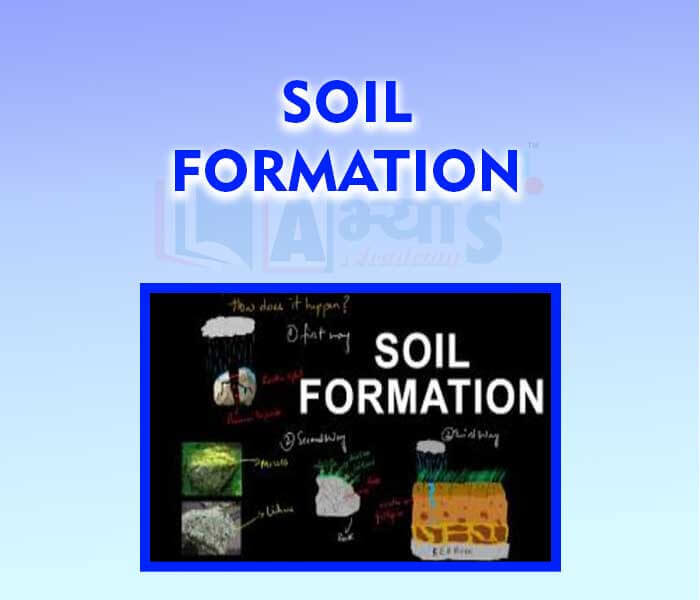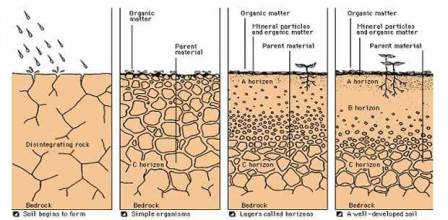Soil Formation

Soil Formation
Soil Formation : The uppermost layer of the Earth surface is called soil. It is usually composed of a thin layer of minerals which include sand, mud, and rock particles, and a layer of dead and decayed plant and animal remains called humus.
Soil formation is a slow, stepwise process. It takes thousands of years to form a layer of soil just a few centimetres thick. It is a result of continuous breaking down of rocks by a process called weathering.
Factors affecting Soil Formation : There are a number of factors which affect soil formation, namely, climate, characteristics of the parent rock, and slope of land.
On flat plains, soil remains relatively undisturbed leading to the formation of a thick layer.

define weathering? | |||
| Right Option : A | |||
| View Explanation |
_____________________ is usually present as a thin film around the soil particles. | |||
| Right Option : C | |||
| View Explanation | |||
Which of the following factors affect the nature of soil ? | |||
| Right Option : A | |||
| View Explanation | |||
Students / Parents Reviews [10]
A marvelous experience with Abhyas. I am glad to share that my ward has achieved more than enough at the Ambala ABHYAS centre. Years have passed on and more and more he has gained. May the centre flourish and develop day by day by the grace of God.

Archit Segal
7thOne of the best institutes to develope a child interest in studies.Provides SST and English knowledge also unlike other institutes. Teachers are co operative and friendly online tests andPPT develope practical knowledge also.

Aman Kumar Shrivastava
10thAbhyas is a complete education Institute. Here extreme care is taken by teacher with the help of regular exam. Extra classes also conducted by the institute, if the student is weak.

Om Umang
10thIt was good as the experience because as we had come here we had been improved in a such envirnment created here.Extra is taught which is beneficial for future.

Eshan Arora
8thMy experience with Abhyas is very good. I have learnt many things here like vedic maths and reasoning also. Teachers here first take our doubts and then there are assignments to verify our weak points.

Shivam Rana
7thI have spent a wonderful time in Abhyas academy. It has made my reasoning more apt, English more stronger and Maths an interesting subject for me. It has given me a habbit of self studying

Yatharthi Sharma
10thIt has a great methodology. Students here can get analysis to their test quickly.We can learn easily through PPTs and the testing methods are good. We know that where we have to practice

Barkha Arora
10thBeing a parent, I saw my daughter improvement in her studies by seeing a good result in all day to day compititive exam TMO, NSO, IEO etc and as well as studies. I have got a fruitful result from my daughter.

Prisha Gupta
8thMy experience with Abhyas academy is very good. I did not think that my every subject coming here will be so strong. The main thing is that the online tests had made me learn here more things.

Hiya Gupta
8thMy experience was very good with Abhyas academy. I am studying here from 6th class and I am satisfied by its results in my life. I improved a lot here ahead of school syllabus.




